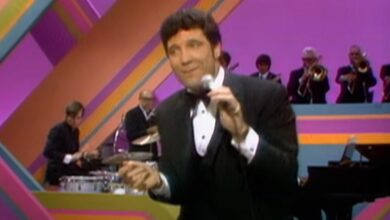Earl Thomas Conley’s “Holding Her and Loving You” Redefines Country Heartbreak with Chart-Topping Poise in 1983
In 1983, Earl Thomas Conley released a song that would not only climb to the top of the country charts but forever change how emotional complexity was expressed in mainstream country music. “Holding Her and Loving You” was the kind of ballad that didn’t just tell a story—it confessed a soul’s dilemma. With its soaring chorus and heart-wrenching narrative, the song struck a chord with listeners, earning Conley his fourth Number One hit and solidifying his reputation as one of country’s most introspective voices of the 1980s.
Conley was no overnight sensation. Born in Portsmouth, Ohio, and raised in working-class Southern grit, he brought an authenticity to his music that few could match. Before becoming a full-time musician, he served in the U.S. Army and worked odd jobs while chasing his dream in Nashville. Unlike many of his contemporaries, Conley was a songwriter first, penning hits for other artists before stepping into the spotlight himself. His deep, gravelly tone and melancholic delivery gave his songs an edge of realism, setting him apart in a decade defined by smooth production and glossy visuals.
“Holding Her and Loving You” was co-written by Walt Aldridge and Tom Brasfield—two songwriters well-versed in navigating the emotional tensions of love and longing. The song’s central conflict is raw yet relatable: a man who’s in love with one woman while still physically with another. Rather than glorifying infidelity, it paints a tortured, nuanced portrait of emotional conflict. The honesty in the lyrics resonated with listeners who understood that relationships aren’t always cleanly resolved—and that the heart often lives in contradiction.
The recording itself was a masterclass in production. Guided by producer Nelson Larkin, Conley’s vocal performance is restrained but heavy with emotion, letting each phrase carry its own weight. The arrangement builds gradually—starting with a simple guitar and rhythm section, then swelling with strings and backing harmonies by the final chorus. The result is a crescendo of heartbreak, with Conley’s voice growing more impassioned as the internal conflict reaches its peak. It was polished, yes, but never artificial—proof that studio production and authenticity could coexist.
Upon its release, the song was met with critical acclaim and commercial success. It reached No. 1 on the Billboard Hot Country Singles chart and remained on the chart for a total of 14 weeks. As the second single from Conley’s Don’t Make It Easy for Me album, it helped him achieve a rare feat in country music history: four Number One singles from the same album. This achievement placed him in a league of his own and set a new standard for consistency and quality in country albums.
Beyond the numbers, the song’s impact was felt across the genre. It helped usher in a new era of emotionally intelligent country music—songs that didn’t just tell stories of barroom heartbreak or honky-tonk nights but explored deeper human struggles. “Holding Her and Loving You” was not just about love lost or gained; it was about love complicated, layered, and painfully real. It expanded what country radio could sound like, bridging traditional themes with modern emotional candor.
The success of the song marked a turning point in Conley’s career. Already building momentum from earlier hits like “Fire and Smoke” and “Somewhere Between Right and Wrong,” this song elevated him to headliner status. It opened doors to national television performances, major festival bookings, and a broader fan base that extended well beyond the Southern states. It also validated Conley’s instincts as an artist willing to take emotional risks in his music.
In the broader context of country music, the song helped pave the way for the more introspective, emotionally vulnerable male artists that would follow. Singers like Vince Gill, Randy Travis, and eventually Keith Urban would build on this model, combining lyrical honesty with melodic sophistication. Conley didn’t just create a hit—he contributed to a shift in how masculinity could be expressed through country music.
Several artists have paid tribute to the song in the decades since its release. It has been covered in both live and studio versions by artists such as Clay Walker and Lee Brice, who have praised its lyrical honesty and emotional depth. Each rendition brings a slightly different tone, but all circle back to the same core truth: love is rarely tidy, and that messiness is what makes it human.
The song’s release coincided with a particularly successful phase in Conley’s career, yet it was also a personally grounding moment for the artist. He often spoke about how deeply he connected with the song, not necessarily because of a specific event in his own life, but because of its universal truth. That connection—between artist and material—is what gave the performance its timeless weight.
Even today, “Holding Her and Loving You” remains one of Conley’s most frequently played songs on classic country radio. It regularly appears on greatest hits compilations and is considered essential listening for anyone studying country music’s golden era of the 1980s. Its enduring appeal lies in its relatability—after all, who hasn’t struggled to reconcile what the heart feels with what life demands?
In terms of musical influence, the song set a bar for emotional storytelling. It wasn’t just about a memorable hook or a singalong chorus. It was about creating a space where listeners could confront their own inner dilemmas through someone else’s voice. That depth of engagement is rare, and when it lands, it leaves a lasting imprint.
Though Earl Thomas Conley passed away in 2019, the legacy of “Holding Her and Loving You” continues to speak for him. It serves as both a career milestone and a cultural marker, encapsulating his unique contribution to the genre. He wasn’t the loudest or flashiest artist of his time, but he was often the most emotionally honest—and that honesty is what continues to resonate.
In the grand landscape of country music, this song stands as a testament to the power of restraint, nuance, and narrative truth. It’s a ballad that dared to explore the gray areas of love and loyalty, and in doing so, it carved out a place not just in the charts, but in the hearts of millions. For Earl Thomas Conley, it was more than a hit—it was a defining moment, and for country music, it was a quiet revolution.



